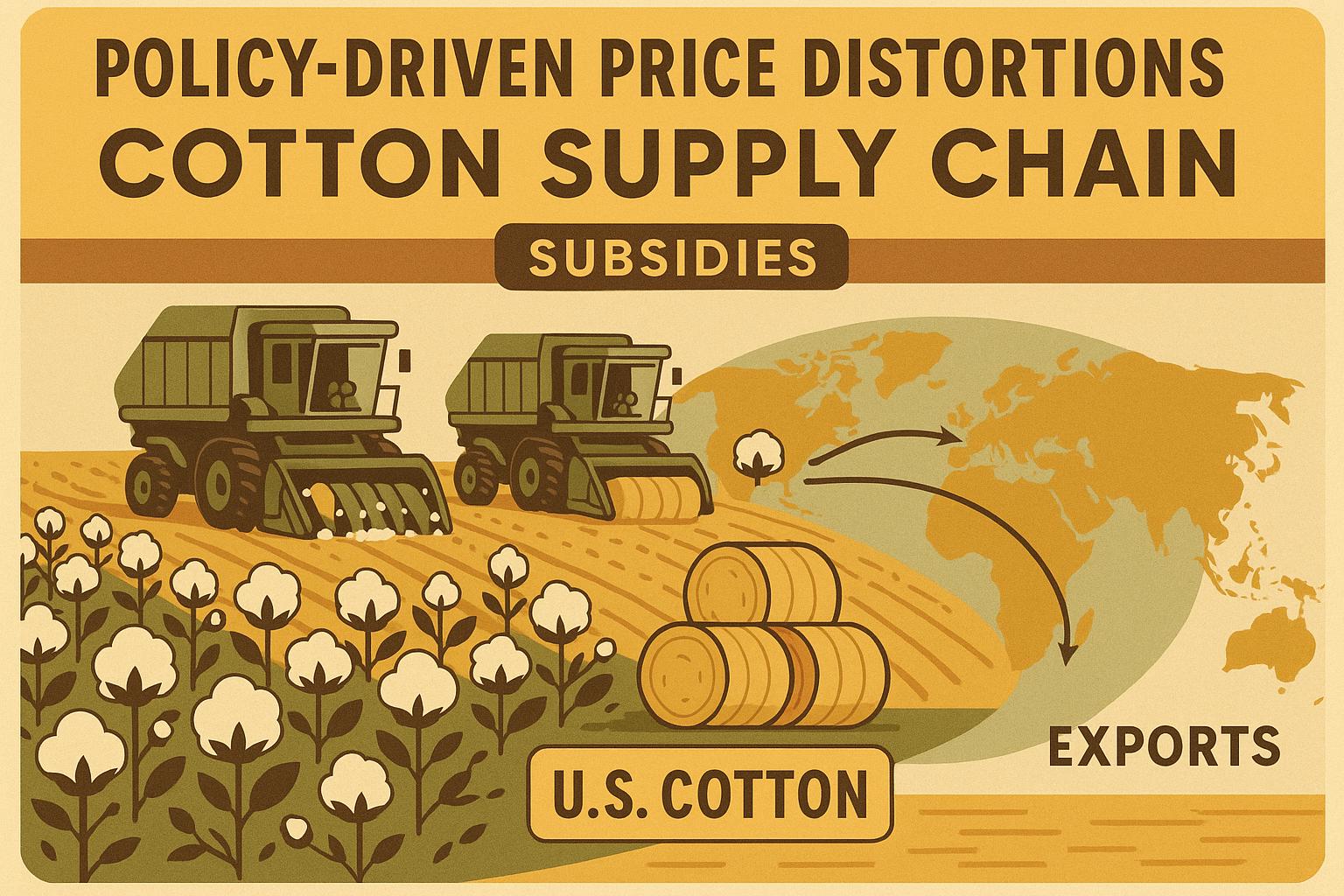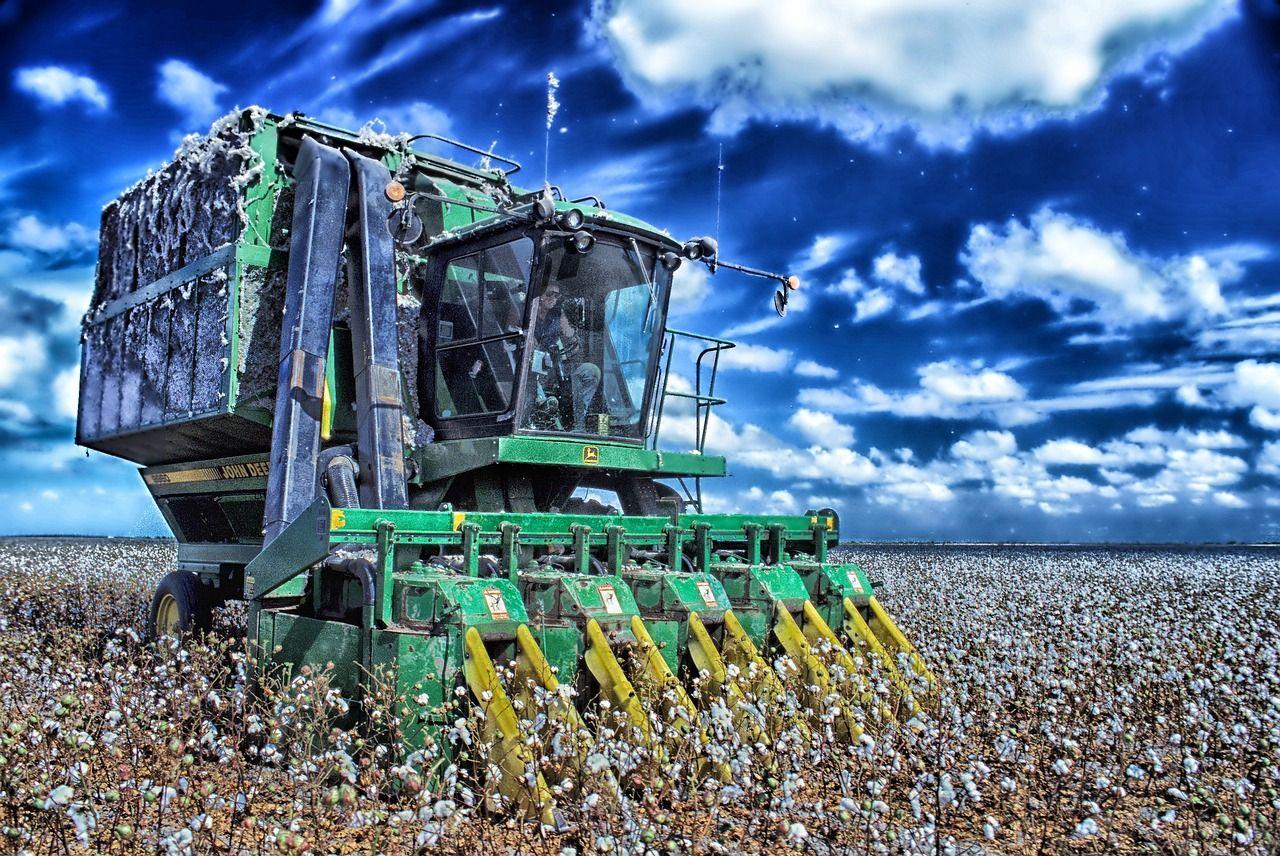Global cotton subsidies reached $8 billion in 2022/23, a 66% increase from the previous year, significantly impacting global cotton prices and competition. Here's what you need to know:
- China leads in subsidies: Over the last decade, China provided $41 billion in cotton subsidies, compared to $7 billion by the U.S.
- Subsidy reliance: 83% of global cotton production benefits from subsidies, with China, India, and the U.S. as top contributors.
- Impact on global markets: Subsidies depress global prices, hurting non-subsidized producers, especially in West Africa, where cotton is vital for economic survival.
- Key challenges: Price disparities, trade tensions (e.g., U.S.–China), and market distortions continue to undermine fair competition.
Quick Comparison
| Country/Region | Subsidy Amount (2022/23) | Key Features | Challenges |
|---|---|---|---|
| China | $2.40 billion | Price support, import controls, Xinjiang focus | Global price depression, inefficiencies |
| India | $2.97 billion | Direct payments | High domestic costs |
| U.S. | $1.64 billion | Crop insurance, price support | Market distortions, trade disputes |
| West Africa | Minimal | Low production costs | Vulnerable to global price shifts |
Bottom line: Cotton subsidies create both stability and market imbalances. To ensure fair competition, reforms like reducing trade barriers, modernizing subsidy structures, and supporting developing markets are essential.
How Western Subsidies Make Africans Poorer
1. U.S. Cotton Support Programs
Since the 1933 Farm Bill, the U.S. has maintained a system to support its cotton producers, with $1.47 billion in premium subsidies provided in 2022 alone.
The framework relies on several key mechanisms:
Crop Insurance Programs
Federal crop insurance forms the backbone of this support, with the government covering 60% of insurance premiums. The USDA's Risk Management Agency (RMA) oversees two main types of policies:
| Insurance Type | Coverage Details |
|---|---|
| Revenue Protection | Protects against revenue losses due to yield reductions or price drops |
| Yield Protection | Covers losses caused by lower crop yields |
In addition to insurance, price support programs play a crucial role in stabilizing the market.
Price Support Mechanisms
The 2014 Farm Bill eliminated direct payments but introduced new tools like Price Loss Coverage, Agriculture Risk Coverage, and Marketing Assistance Loan Programs to help stabilize prices. For example, during the 2019–20 season, U.S. cotton farmers received over $2 billion in support payments. These measures not only safeguard domestic producers but also ripple through global markets, influencing international cotton prices.
"Government would like farmers to grow certain commodities, the big players - corn, wheat, soybeans. By offering those incentives, the farmer's going to go, 'Well, I can make the most money planting corn, because I'm guaranteed this amount of money.'"
– Gabe Brown
Market Impact
Historically, U.S. cotton support programs have had a noticeable effect on global markets. For instance, in the mid-2000s, these policies were linked to a 12% reduction in global cotton prices. Considering that U.S. farmers contribute about one-third of the world's cotton exports, the influence of these programs is substantial.
Production Trends
The amount of insured farmland has skyrocketed - from 206 million acres in 2000 to 493 million in 2022. While this growth reflects the success of domestic policies, it also raises concerns about market distortions and potential environmental consequences.
"The rental market is incredibly hard, and ground is selling at record highs in the Midwest - certainly farm ground. Because of this artificially inflated price, in my opinion, those with lesser means are unable to get into the business or to expand."
– Bill Furlong
Between 2009 and 2018, the average cotton subsidy per acre doubled. Additionally, the 2018 Farm Bill introduced provisions that could shield U.S. cotton producers from global market fluctuations. While this benefits domestic farmers, it risks harming producers in developing countries and could trigger further disputes under World Trade Organization (WTO) rules.
2. Chinese Cotton Policy Framework
Over the past decade, China has solidified its position as the global leader in cotton subsidies, providing a staggering US$41 billion - a figure nearly six times greater than the US$7 billion contributed by the United States. This accounts for about 75% of all cotton subsidies worldwide. Such extensive financial support has significantly altered the global cotton market landscape.
Subsidy Structure and Market Control
China's approach to supporting its cotton industry relies on several key mechanisms:
| Support Mechanism | Implementation Details |
|---|---|
| Direct Subsidies | Financial aid directly aimed at boosting cotton production. |
| Import Controls | Tariffs as high as 40% on cotton imports to protect domestic producers. |
| Price Support | Management of government reserves to stabilize prices. |
| Regional Focus | Heavy emphasis on supporting cotton production in Xinjiang. |
Xinjiang plays a central role in China's cotton strategy, accounting for an overwhelming 92.3% of the country’s cotton production during MY 24/25. These mechanisms collectively shape China's domestic policies and influence global market trends.
Production and Trade Impact
China's subsidy policies have far-reaching effects, both domestically and globally. Despite production costs being nearly four times higher than in some African countries, China maintains its competitive edge through its robust subsidy framework. This has led to two major outcomes:
- Domestic Market Distortion: Subsidies encourage higher production levels, reducing the need for imports and creating inefficiencies within the domestic market.
- Global Price Depression: By flooding the market with subsidized cotton, China drives down global prices, adversely impacting farmers in other countries.
These policies not only disrupt China's domestic market but also contribute to broader international trade challenges.
Trade Relations and Barriers
China's cotton policies have caused significant friction in trade relations with the United States. Key developments include:
- A 73% drop in U.S. cotton exports to China during the first seven months of MY 24/25.
- Retaliatory tariffs imposed by China, reaching as high as 140%, effectively cutting off U.S. cotton imports.
- The U.S. share of the Chinese cotton market shrinking from 29.6% to 17.1% year-over-year.
These measures have severely impacted U.S. cotton producers, further straining bilateral trade ties.
Future Trajectory
Looking ahead, China plans to expand its cotton processing capabilities in Xinjiang, with a goal to process 45–50% of the region’s cotton by 2028. This continued focus on domestic production and processing underscores the likelihood that China's subsidy framework will remain a dominant force in shaping global cotton markets.
"Without tackling China's subsidies and other harmful trade practices, any effort to improve the plight of poor cotton farmers globally is doomed to fail."
- Kristen Hopewell, Canada Research Chair in Global Policy at the University of British Columbia
3. West African Cotton Market Position
The Cotton-4 group - Benin, Burkina Faso, Chad, and Mali - holds an important place in global cotton production. Despite representing just 3% of the world’s total cotton output, these nations are known for their efficient production methods. However, they face significant challenges, particularly from global subsidy policies that distort the market.
Economic Significance and Export Dependence
Cotton is a cornerstone of West African economies, especially as a key export commodity. For Burkina Faso, it accounts for a striking 59% of total exports. In Mali, Benin, and Chad, it contributes between 25% and 45% of their exports. Moreover, the sector provides livelihoods for more than one million households across these countries.
| Country | Cotton's Share of Exports |
|---|---|
| Burkina Faso | 59% |
| Mali | 25–45% |
| Benin | 25–45% |
| Chad | 25–45% |
This heavy reliance on cotton exports highlights the vulnerability of these economies to global market shifts and subsidy-driven distortions.
Competitive Advantages and Market Challenges
West African cotton producers boast a major cost advantage, with production costs roughly 25% of those in China. Yet, this natural efficiency is overshadowed by international subsidies, which disrupt fair competition and tilt the playing field against them.
Price Disparities and Market Access
West African farmers also struggle with significant price disparities in global markets. For instance, during 2011–2012, they earned only half of what U.S. growers received, despite producing lower-quality cotton.
"West African farmers will benefit from buoyant world cotton prices only if they are able to negotiate a significantly higher price at the national level where price setting mechanisms and monopsonistic markets determine their share of world market prices." – ScienceDirect
Production Growth and Persistent Challenges
Between 1970 and 2005, cotton production in West Africa increased tenfold. However, this growth has not eliminated long-standing structural issues. Farmers face persistent hurdles such as:
- Price volatility in global markets
- Limited access to modern technologies
- Fixed exchange rates that reduce competitiveness
- Market distortions caused by subsidized competitors
A stark example of these challenges occurred in the early 1980s. While global cotton prices ranged between 200 and 250 CFA francs per kilogram, West African producers were paid just 60 to 70 CFA francs per kilogram.
"American cotton subsidies are destroying livelihoods in Africa and other developing regions. By encouraging over-production and export dumping, these subsidies are driving down world prices – now at their lowest levels since the Great Depression." – Kevin Watkins, Oxfam International
sbb-itb-0e617ca
Benefits and Drawbacks
Building on the regional analyses above, let’s take a closer look at the broader advantages and challenges of global cotton subsidy systems. These subsidies, which vary significantly by region, bring both opportunities and obstacles to the table.
Regional Support Mechanisms
The impact of cotton subsidies isn’t uniform - it depends heavily on the region. During the 2019–20 growing season, global government support for cotton reached a staggering US$8 billion, marking a 39% jump from the previous year. On average, subsidies provided 20 cents per pound, while cotton prices hovered around 60.4 cents per pound.
| Region | Support Type | Primary Benefits | Key Challenges |
|---|---|---|---|
| United States | Direct payments, insurance | Revenue stability | Market distortion |
| China | Price support, stockpiling | Income security | High storage costs |
| West Africa | Limited support | Low production costs | Price vulnerability |
| Australia | R&D focus | Innovation | Limited direct support |
Economic Implications
The U.S. stands out as a prime example of how subsidies can stabilize domestic markets while introducing complexities. Since 1995, American cotton producers have received an average of US$2.1 billion annually in subsidies. This accounts for roughly 50% of the crop's actual value. While this support ensures revenue stability for farmers, it also distorts global market prices.
"If you look at it from a purely economic view, it probably doesn't make sense to pay someone a subsidy to grow a crop when you could buy it from somewhere else cheaply and focus on what you're good at."
- Rob Eveleigh Mob, Chair of the Lower Namoi Cotton Growers' Association, New South Wales, Australia
Environmental and Social Impact
Cotton farming carries a hefty environmental cost. The industry consumes about 10% of all agricultural chemicals, nearly 25% of global insecticides, and incurs US$2 billion annually on agricultural pesticides. These environmental challenges, combined with the market imbalances created by subsidies, have fueled trade tensions that we’ll explore further below.
Market Distortions and Trade Relations
Subsidy programs have sparked significant international disputes. A key example is the 2002 Brazil–U.S. trade conflict, where the WTO authorized Brazil to impose US$147.3 million in annual countermeasures against the U.S.. This case underscores how subsidies can escalate tensions and disrupt trade relationships.
Development Impact
For developing nations, the effects of subsidies are particularly stark. In some of the world’s poorest regions, producing a single metric tonne of cotton creates jobs for about five people. Subsidies in wealthier nations often undermine these efforts, distorting international prices and slowing local development.
Future Considerations
A shift is underway in how subsidies are structured. Wealthier nations are increasingly directing support toward R&D and innovation, while developing countries continue to rely on subsidies to spur industrial growth and promote exports. This evolving approach could reshape the competitive dynamics discussed earlier.
Summary and Recommendations
The global cotton market faces a range of challenges, from subsidy policies to restrictive trade barriers. For example, U.S. cotton exports to China dropped by a staggering 73% in MY 24/25, with market share shrinking from 29.6% to 17.1%. This sharp decline highlights the urgent need for policy reforms to address these issues.
Policy Reform Priorities
The table below outlines key areas for reform, the current challenges, and actionable steps to improve the global cotton market:
| Reform Area | Current Challenge | Recommended Action | Expected Benefit |
|---|---|---|---|
| Subsidy Structure | Overprotective subsidy policies | Shift to performance-based incentives | More efficient markets |
| Trade Barriers | 140% tariffs on U.S. cotton | Engage in multilateral negotiations | Greater market access |
| Development Support | Limited aid for emerging markets | Launch technology transfer programs | Improved global competitiveness |
These reforms are essential for stabilizing the cotton market and creating a fairer playing field.
Market Stabilization Measures
The disparities in agricultural support are stark: OECD countries provided a hefty $258 billion in agricultural subsidies, while developing nations are projected to face a $35 billion trade deficit by 2030. To stabilize the market and promote fair competition, policymakers must rethink subsidy structures, reduce trade barriers, and encourage sustainable practices.
Strategic Recommendations
To tackle these challenges effectively, consider the following strategies:
-
Modernize Support Systems
Agricultural policies should move beyond outdated protectionist measures. By investing in innovation and infrastructure, especially in emerging markets, countries can help producers navigate trade barriers while ensuring stability. -
Enhance Market Access
Lowering trade barriers is critical to securing equitable market access. This step will not only benefit producers but also strengthen global food security. -
Promote Sustainable Practices
With Xinjiang accounting for 92.3% of China’s cotton production, diversifying production through sustainable and eco-friendly methods is vital. Improving efficiency and adopting green practices should be a priority for the industry.
FAQs
How do U.S. cotton subsidies influence global prices and competition?
The Impact of U.S. Cotton Subsidies on Global Markets
U.S. cotton subsidies have a powerful influence on global cotton prices and international competition. By cutting production costs for American farmers, these subsidies often lead to an excess supply of cotton in the global market. This surplus drives prices down, making it tougher for farmers in countries without similar financial support to stay competitive.
Research shows that U.S. subsidies can reduce global cotton prices by at least 10%. For cotton-exporting nations, especially in Africa, this drop can seriously hurt their export revenues. The uneven playing field created by these subsidies poses significant challenges for producers in unsubsidized regions, leaving them at a disadvantage. The broader effects of these policies reveal the ongoing tension between supporting domestic agriculture and ensuring fairness in global trade.
How do cotton subsidies in the U.S., China, and India differ, and what impact do they have on global markets?
Cotton subsidies in the U.S., China, and India take different forms, each shaping global competition in unique ways.
The United States relies on direct payments and crop insurance to support farmers' incomes and maintain the competitiveness of its cotton industry. While these measures offer stability to American farmers, they often push global cotton prices downward, creating challenges for growers in developing nations.
China emphasizes direct production support, particularly in Xinjiang, the region responsible for most of its cotton output. This approach bolsters its domestic production but can lead to disruptions in international markets.
India takes a mixed approach, combining price support with direct cash transfers aimed at improving rural livelihoods and addressing food security concerns. However, these subsidies often face criticism for being inefficient and having a limited impact.
Each country's strategy reflects its specific economic goals and agricultural policies, influencing global cotton markets and competition in distinct ways.
How do U.S. cotton subsidies affect West African farmers and their ability to compete globally?
U.S. cotton subsidies have a profound effect on farmers in West Africa, particularly in the Cotton-4 nations - Benin, Burkina Faso, Chad, and Mali. These subsidies lead to overproduction in the U.S., which in turn pushes global cotton prices down. This makes it extremely difficult for West African farmers to compete on a level playing field in international markets.
For millions of farmers across these countries, cotton is more than just a crop - it’s their main source of income, providing for their families and communities. But with prices kept artificially low due to these subsidies, African producers face staggering financial losses, estimated at $250 million every year. This economic strain hampers their ability to grow and compete within the global cotton trade, presenting a significant obstacle to the development of their local economies.


